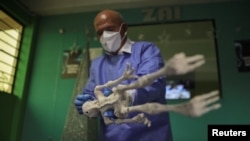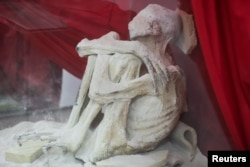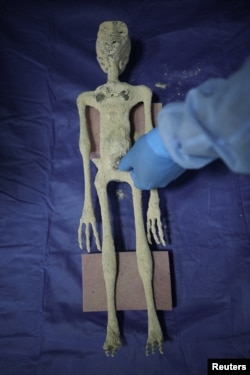Leandro Rivera says he chanced upon the cave in Peru's remote Nazca region that contained hundreds of pre-Hispanic artifacts – including human bodies with elongated heads and what appeared to be only three fingers on each hand.
The plateau is famous for the Nazca lines, incisions on the desert floor forming birds and other animals visible from the air. The ancient geoglyphs have long intrigued anthropologists and exert a powerful fascination over some believers in extraterrestrials.
Nazca is also known for salt flats that dehydrate and preserve human and animal remains, making it the site of important archeological finds that have deepened modern understanding of ancient cultures – and attracted grave robbers.
Rivera was convicted in 2022 of assault on public monuments for unearthing the artifacts. He received a four-year suspended sentence and was fined about 20,000 Peruvian soles ($5,190), short of the maximum penalty of an eight-year prison term.
His haul was thrust into the spotlight last year when two of the mummies ended up in Mexico as the centerpiece of congressional hearings on UFOs and extraterrestrial life. Mexican journalist Jaime Maussan presented the bodies as a sign of life beyond Earth – a claim dismissed by scientists.
In an interview with Reuters, Rivera said he removed as many as 200 sets of remains from the cave, and some bodies had been smuggled out of Peru to France, Spain and Russia.
The presentation of bodies in Mexico – as well as Rivera's claims to have dozens more – have prompted some experts to ask whether Peru is losing the battle to stop the plunder of its archaeological sites to feed a lucrative black market for mummies and other pre-Hispanic artifacts.
"Peru has done a lot of work to try and control this trade," said Christopher Heaney, a Latin American history professor at Penn State University and author of a book on Peruvian mummies. "But this implies that these claims for government success need to be re-examined a bit if objects like (the bodies in Mexico) can leave the country."
Peru's Culture Ministry did not respond to questions about the effectiveness of its efforts to control trafficking.
Reuters was granted rare access to the ministry's anti-smuggling unit at Lima's international airport and spoke to four government officials who said stricter penalties, more resources and better coordination were needed to fight the looting.
Tomb raiders trade tips online
Archaeological materials including human remains command high prices on a black market controlled by well-organized criminal groups, experts said.
Since the COVID-19 pandemic, trafficking in cultural goods has exploded around the world, according to UNESCO and the World Customs Organization (WCO).
Antiquities stores that had previously relied on in-person shopping turned to online sales to survive.
Black-market sellers took advantage of the greater privacy online or resorted to encrypted channels.
The shift to an online black market also allowed buyers to seek out illegal goods rather than wait for invitations to in-person events, as the trade was typically run pre-pandemic, a WCO official told Reuters.
And tomb raiders went online to share information about how to locate and raid vulnerable sites.
"Social networks have become spaces for the sale of works of art and antiques of illegal origin, and unfortunately this traffic has increased during the COVID-19 pandemic," said Enrique Lopez-Hurtado, who was until recently the coordinator of the culture sector of UNESCO Peru.
The sheer volume of online sales — and the demands of pandemic safety protocols — presented challenges for customs officials inspecting shipments and trying to intercept illegal goods, the WCO official said.
Guido Lombardi, a medical doctor and anthropologist at the Peruvian University of Cayetano Heredia who specializes in mummy studies said he has received anonymous texts on WhatsApp offering looted objects for sale including terracotta figurines that are hundreds of years old.
Flavio Estrada, an archaeologist at the Institute of Legal Medicine and Forensic Sciences in Lima who assisted in the 2017 investigation of Rivera, said smuggling networks also market fakes, constructed out of animal bones and papier-mache.
In some cases, alien enthusiasts exploit a lack of understanding of cranial remodeling, a documented social practice in Pre-Colombian times that involved binding a child's head to manipulate the shape, Lombardi said.
"There were no people who were born like this, as some of the theorists of 'ancestral aliens' also try to make us believe," he said. "There's a whole contemporary mythology around this topic, and that generates a market."
While cranial modification was a practice in some of Peru's ancient cultures, Estrada said it is likely that grave robbers altered the Nazca remains to make it look like they had only three fingers on their hands in a bid to appeal to those who subscribe to the notion of extraterrestrials.
Changing attitudes
In recent years, there has been a global change in attitudes toward displaying the remains of Indigenous people. Reputable museums have begun to repatriate bodies to their countries of origin.
But there is still demand for remains and other artifacts from private collectors in the United States and Europe looking for status symbols and alien enthusiasts, 10 experts interviewed by Reuters said.
The WCO official also cited a social media market for buying skeletons and scalps, which has been growing in popularity over the last 10 years.
Stopping looted items from leaving Peru is challenging. Peru shares borders with five countries and has 27 border crossings.
At Lima's international airport, experts from Peru's culture ministry monitor security checkpoints for suspected cultural material picked up by x-ray scanners.
Officials seize between four and 10 items a year, compared to 200 a month in 2008, said Rolando Mallaupoma an archeology analyst in the recovery unit of the culture ministry.
Mallaupoma attributes the decline to the ministry's work educating vendors in tourist areas on how to identify authentic culture goods.
"In most cases what they [tourists] are going to say is that they didn't know, and there will not be any criminal action," Mallaupoma said. The item will be confiscated and turned over to the ministry.









